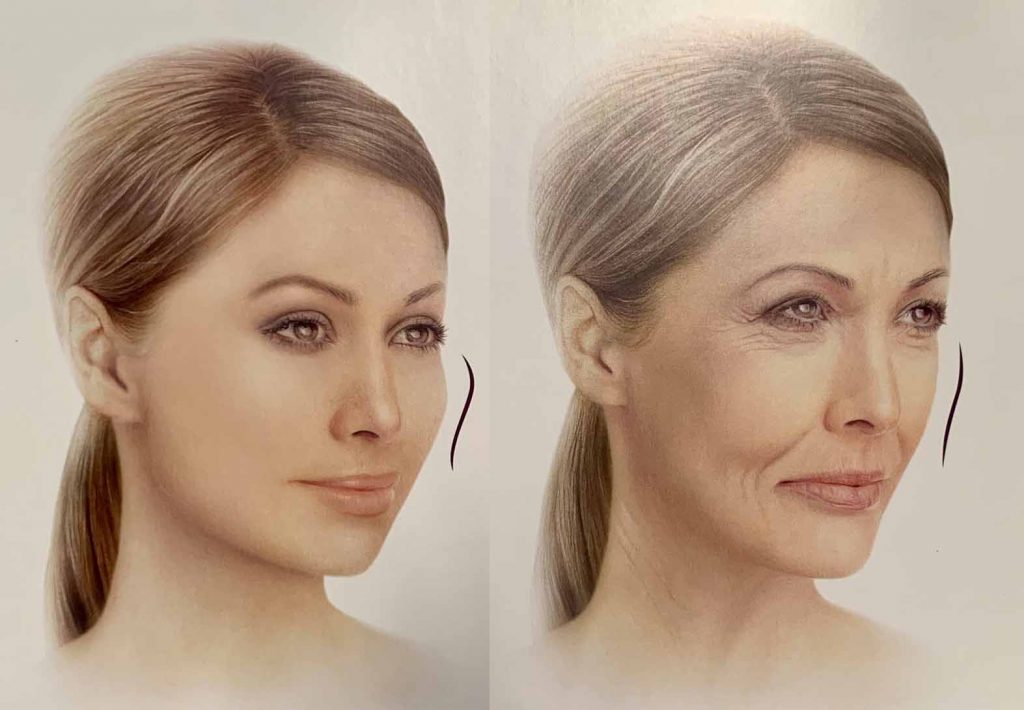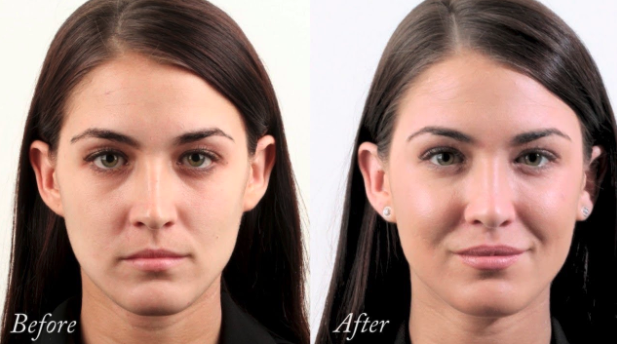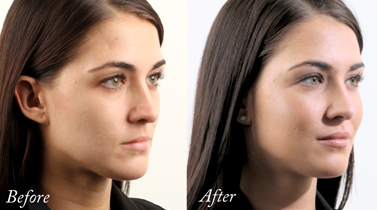Cheek Enhancement and Cheek Volume Replacement Melbourne
As we age, our faces naturally lose volume. Volume loss occurs in the skin, fat, muscle and bone, leading to the appearance of facial folds such as the nasolabial folds. In a study by Boehm et al., it was found in facial CT scans that the superficial and deep midface lost volume, 26.10 mL to 23.15 mL and 11.01 mL to 8.98 mL, respectively, over ten years.
Treatments to restore mid-face or cheek volume can help reduce the appearance of this age-related change.
What does cheek enhancement do?
As cheeks lose volume with ageing, the face may become less proportionate and balanced. Replacing the volume in the cheek can help to regain facial proportions and rejuvenate the face. As skin sags with ageing, replacement of cheek volume can help to lift this sag.
For the younger population, there may be volume deficiencies in the cheek that are not due to ageing. For example, the maxilla (the bone that forms the upper jaw) may be underdeveloped, leading to a flatter mid-face and disproportion of the mid-face with the rest of the face. Enhancement the cheeks can help to correct this by adding volume to this area.
Replacing volume in the mid-cheek can also support the lower eyelid to help reduce the appearance of tear troughs or ‘eye bags’. This supports the ligaments around the lower eyelid that may sag with time.
Most people will also naturally have some asymmetry of the cheeks. Treating the cheek area can help balance pre-existing asymmetry to a certain degree, although absolute symmetry is unlikely.
In summary, replacing volume in the cheeks can help enhance the following:
- The shape and proportions of your cheeks in relation to the rest of the face
- The size of your cheeks in relation to the rest of the face
- The skin on your cheeks
- Provide structural support for the lower eyelid
- Improve the symmetry of your cheeks
The ogee face curve
The ogee curve, a term commonly used in architecture, describes an S-shaped curve. In cosmetic medicine, the term “ogee face curve” refers to a specific facial contour. It describes the face’s gentle, double-curved shape when viewed from the side, as shown in the diagram below.
The ogee face curve is characterised by a convexity in the forehead area, followed by a slight concavity or flatness in the upper eyelid region. The curve then transitions into a convex contour in the mid-face or cheek area and finally curves inward slightly along the jawline.
Treatments that replace volume in the cheeks can help restore the ogee face curves by tightening the skin and adding volume to specific areas.

Diagram to demonstrate the ogee curve
If you observe the light reflection from a cheek with an ogee curve, you will notice a certain point where this light reflection is strongest. Often this point coincides with the point of maximal projection. Mathematical formulas using the Golden Ratio, or Phi, can be used to find and replace volume in this point on the cheek.
Options for enhancing cheek volume
There are several options available for enhancing cheek volume. These include:
- Non-surgical volume loss replacement: Treatments are available to augment cheek volume and enhance contours.
- Fat transfer: Fat transfer, also known as fat grafting or fat injections, involves the removal of fat from one area of the body (typically through liposuction) and injecting it into the cheeks to add volume. Fat transfer requires a surgical procedure and may have a longer recovery time than dermal fillers. Fat transfer is not performed at Victorian Cosmetic Institute.
- Cheek implants: Cheek implants are solid materials typically made of silicone or other biocompatible substances surgically placed in the cheeks to enhance volume and contour. This procedure involves an incision and the insertion of implants to achieve the desired effect. Recovery time may be longer compared to non-surgical options.
- Thread lift: A thread lift is a procedure where dissolvable threads are inserted under the skin to lift and support sagging tissues, including the cheeks. The threads stimulate collagen production, providing a subtle lift and enhancing volume.
- Emface: Emface is a treatment that combines Radiofrequency and High-Intensity Facial Electrical Stimulation to tighten the skin and improve muscle tone, providing a lifting effect.
Cheek volume enhancement consultation and assessment
When you have your initial consultation, the cosmetic doctor will physically examine your cheek shape, structure and size. Cheek enhancement should be done with consideration of the facial proportions. Your doctor will also discuss your treatment expectations and your overall suitability for treatment.
Factors such as cheek volume, pre-existing asymmetries, skin quality, skin laxity and facial proportions will need careful assessment.
Your practitioner will then advise the proposed treatment plan and provide a written quotation and treatment plan.
How cheek enhancement is performed
How your cheek enhancement is performed depends on which treatment you and your doctor have decided upon.
If treatment involves any injectable products, cannulas are used as they are generally longer than their counterpart needles; so fewer entry points are needed, reducing the risk of bruising. A local anaesthetic will be used to numb the site, and the doctor will use a technology called Accuvein to visualise and map your veins to reduce the risk of bruising and vascular occlusion.
With most treatments, it is advised to give yourself some recovery time afterwards, as there may be some swelling or bruising after getting cheek treatment.
What are the risks and side effects of cheek volume enhancement?
The risks and side effects with vary depending on the cheek volume enhancement treatment being performed. However, all cosmetic procedures have risks and side effects involved.
If your cheek volume enhancement treatment involves injections or piercing of the skin, some of risks and potential side effects include;
- Bruising
- Swelling
- Lumps
- Asymmetry
- Overtreatment, which may require correction
- Under-treatment, which may require further treatment
Less common risks and side effects include:
- Nodules or granulomas (immune-mediated reactions)
- Allergic reactions
- Infection
- Vascular occlusion. Vascular occlusion is a very rare but severe complication where the facial artery becomes blocked, occluding its blood supply. This can lead to the possible death of the skin supplied by the artery or even blindness or stroke. To minimise the risk of this complication, the Accuvein ultrasound device is used to scan for arteries in the treatment area before and during the treatment.
Skincare and make-up to use after your treatment
All non-surgical face shaping treatments are complemented by healthy skin. Using products such as Vitamin A (retinol), Vitamin B (niacinamide) and sunscreen improves skin quality in the longer term.
- Vitamin A – Retinol is a molecule that improves skin texture, dryness, and fine lines.
- Niacinamide – Nicotinamide and its derivatives have been shown to increase the expression of collagen (type I, III, and V), elastin, and fibrillin (1 and 2) in the skin
- Sunscreen – Regular sunscreen use delays skin ageing in healthy, middle-aged men and women.
For immediate post-treatment skincare, a hydrating hyaluronic acid serum such as the Aspect Dr Penta Hydration serum may assist in boosting hydration and repairing inflamed skin. To learn more about hydration-boosting serums, click here.
After having cheek volume enhancement treatment that involves injections or other piercing of the skin, we generally advise you to avoid make-up for at least one day to reduce the risk of infection. For treatments that do not break or pierce the skin, makeup can usually be applied once any initial redness, heat or swelling has subsided.
How often should I have cheek volume enhancement?
How often you have treatment depends on factors such as age, size of the cheeks in proportion to the rest of the face, the degree of pre-existing cheek volume loss, and which treatments you have been prescribed.
Your doctor will provide you with a written treatment plan and quote, detailing the recommended quantity of treatments to achieve the desired outcome.
How long does cheek volume enhancement treatment last?
This will depend on the type of treatment performed. The results from some cheek volume enhancement treatments are noticed immediately, with the visible results gradually declining over time. In those cases, patients will often have maintenance treatments performed every 6 to 12 months.
Other treatments build volume gradually over time and require multiple treatments over a 3 month period, with maintenance sessions then performed every 6 to 12 months.
Before and after cheek volume enhancement
This patient came to the Victorian Cosmetic Institute wanting to treat the volume loss in her upper face. Her cheeks were treated to add lift at the golden ratio points, with her forehead and lips also receiving treatment.


All procedures carry a risk of side effects and potential complications. The outcome of each procedure cannot be guaranteed, and individual results may vary. A consultation with one of our practitioners is required prior to any procedure to assess suitability for treatment. Patient consent has been obtained to display images.
Why should I choose the Victorian Cosmetic Institute as my provider of cheek volumn enhancement?
There are several treatments available to address volume loss as a result of ageing or genetics. The doctors at Victorian Cosmetic Institute provide a thorough initial consultation to perform a full face assessment, ascertain your particular requirements, discuss your expectations and determine whether you are suitable for cheek volume enhancement treatment.
You can contact our Customer Care team on 1300 863 824 to schedule a consultation with one of our doctors or book your consultation online.
Last updated May 2025
